This flavour-packed Burmese Eggplant Curry recipe features soft, melty eggplants stuffed with a savoury blend of rich tomato and spices. The mainly hands-off method makes it an easy weeknight dinner recipe.
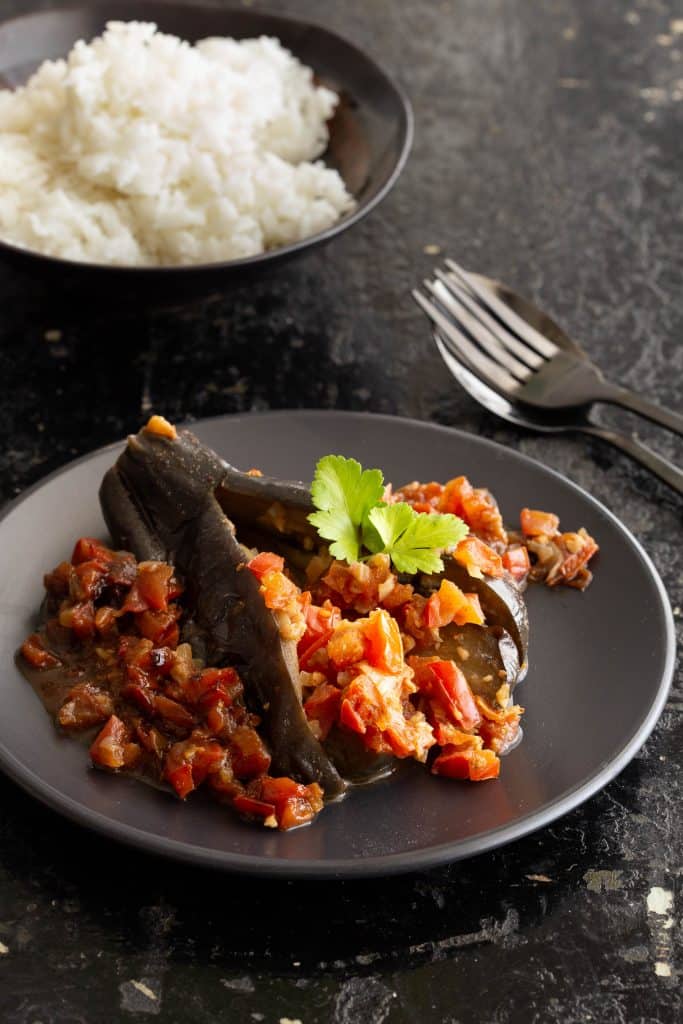
Why We Love This
Known throughout Myanmar as Khayan Thee Hnut (but in Su’s household as ‘That Amazing Brown Dish’) this Eggplant Curry will have you coming back for seconds, thirds and fourths!
It’s rich, fragrant and packed with flavour, making it the perfect dish to share with friends as part of a home-cooked banquet. Just add freshly cooked rice, a crisp salad or two, and a helping of our other delicious Burmese recipe for Lemongrass Chicken Curry.
Related: Vietnamese Chicken Curry / Japanese Beef Curry
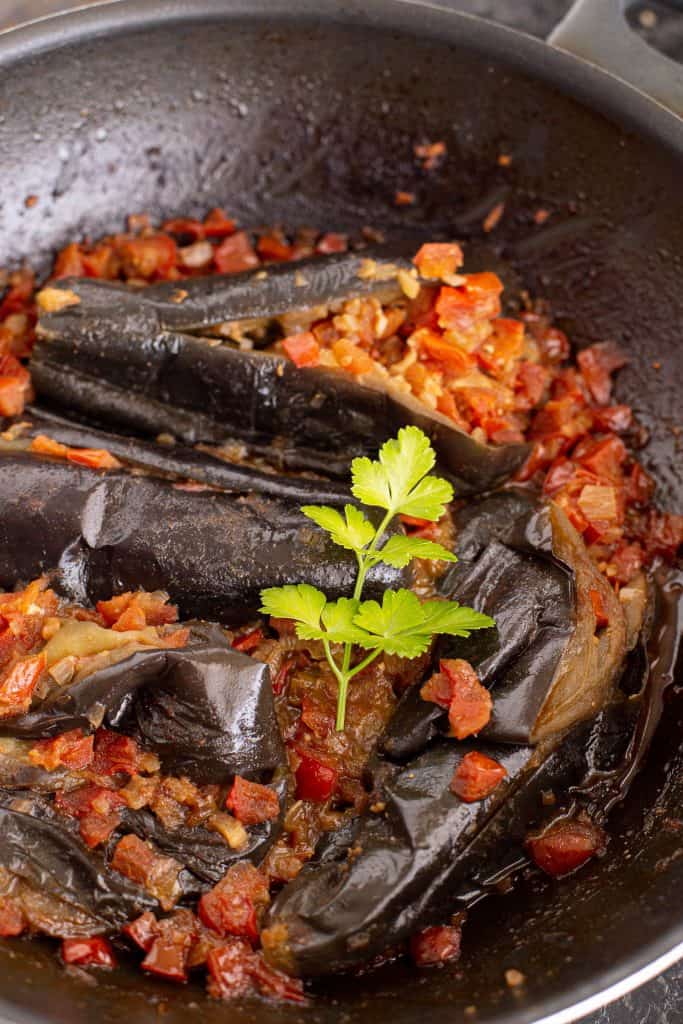
What is Burmese Eggplant Curry?
This traditional Burmese Eggplant Curry is made without coconut milk. The eggplant stuffing / curry sauce base is made from finely sliced shallots, diced red tomatoes, and a blend of Burma’s all-time favourite spices: turmeric, garlic, roasted peanuts and dried shrimp powder to name just a few.
Its rich flavour is savoury, spicy and a little bit sweet – so we recommend serving it with rice to soak up all the delicious juices with a side dish or two to balance out the intense flavour.
As a veggie focused curry recipe, it’s made without meat, but does include fish sauce and dried shrimp powder as seasonings. However, it’s super easy to adapt it to be completely vegetarian or vegan if you need.
For a milder stuffed eggplant recipe, try our Turkish Karniyarik eggplants instead.
Where We Learned This
We first learned this recipe from the lovely ladies at Alice & Su’s Cooking School at Ma Ma Guesthouse in Mandalay. Our day was spent creating a banquet of Burmese dishes like lemongrass chicken, green tomato salad and a delicious mushroom and watercress stir fry.
They taught us that the most authentic way to eat a Burmese banquet is to place a big pile of steamed rice in the centre of your plate. Scoop up a portion of each dish and arrange it around the outside. To eat, mix a little of each dish with some rice into every mouthful. Works for us!
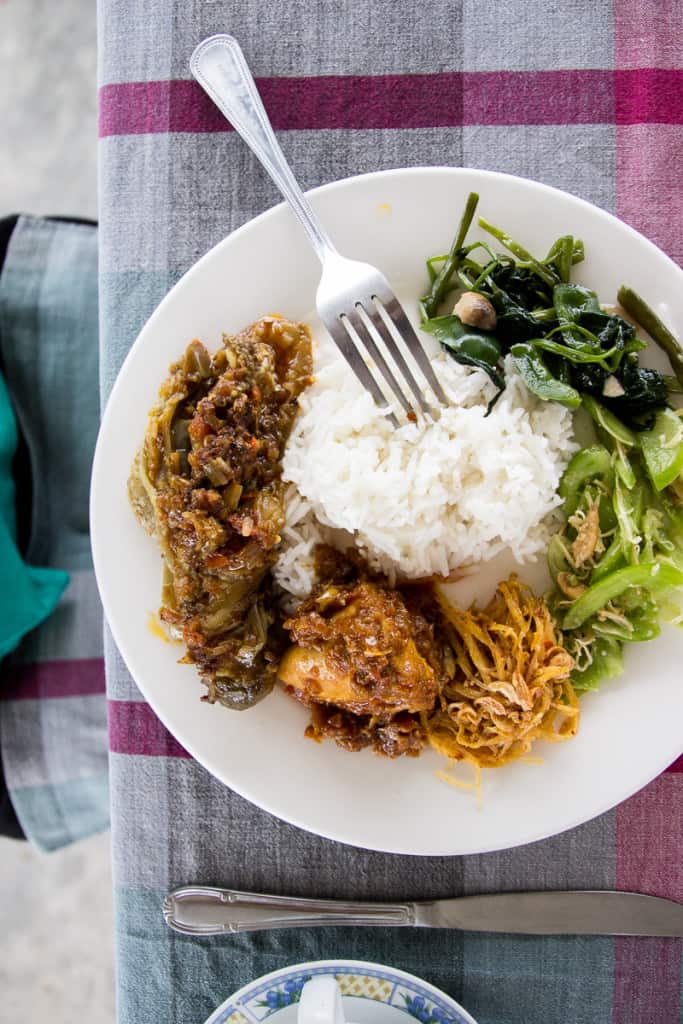
What You’ll Need
- Eggplants – When we first cooked this in Myanmar we used long thin eggplants similar to Chinese/Japanese eggplant varieties. We’ve since cooked this with regular eggplants which work just as well.
- Palm Sugar – The authentic curry eggplant recipe uses a natural sweetener known as jaggery, which in Myanmar is sourced from the Toddy Palm tree. You can find it as a syrup or as a crumbly fudgy ball of buttery caramel flavour, so good that you can eat it on its own. At home, we substitute with gula melaka, palm sugar or brown sugar depending on what we have on hand.
- Fish Sauce – This staple Asian ingredient has a strong smell in the bottle, but isn’t fishy in the final dish, adding a delicious salty, savoury flavour to your cooking. You’ll find it at Asian grocers or in well-stocked supermarkets in the international foods section, or online.
- Dried Shrimp Powder – This is made from fresh baby shrimp/prawns that are dried and then ground into a fine powder. It’s very different from shrimp paste (such as Malaysian belacan or Indonesian terasi) which are fermented first. Look for it at an Asian grocery or get it online. If you have shrimp paste on hand, you can use this instead – start with 1/2-1 tsp and taste, then add more if you want it saltier. Otherwise, just add salt or an extra splash of fish sauce to taste.
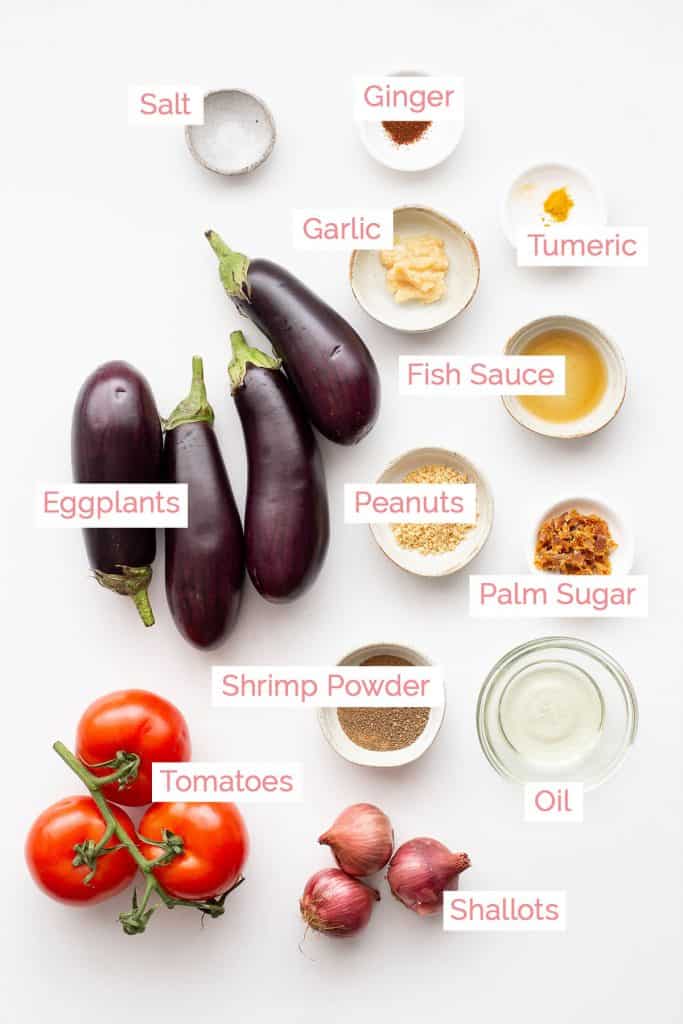
How to Make:
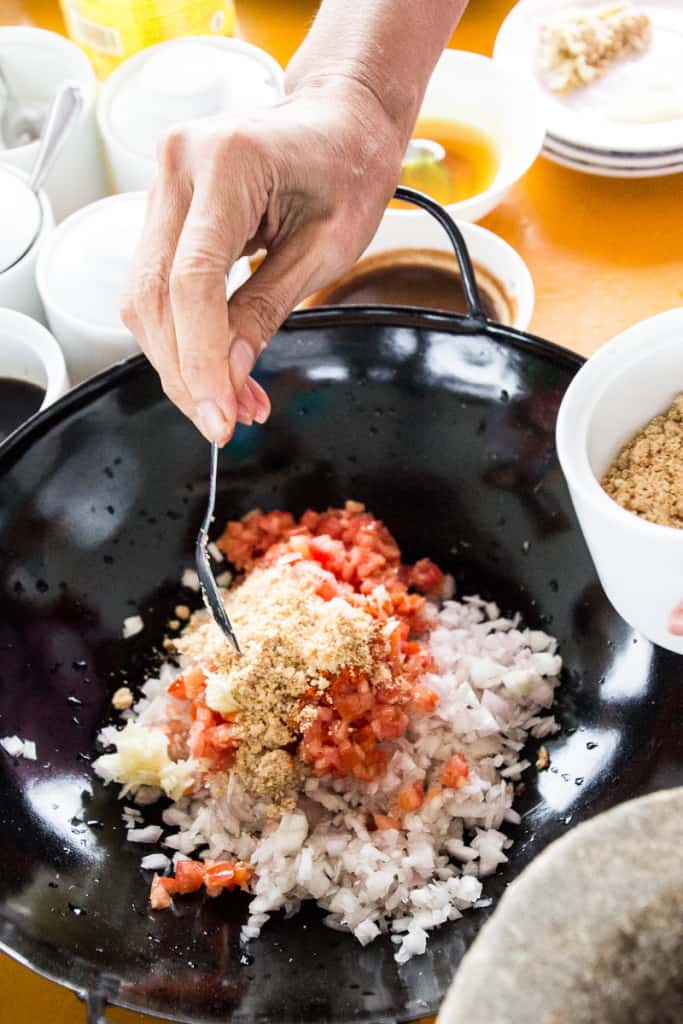
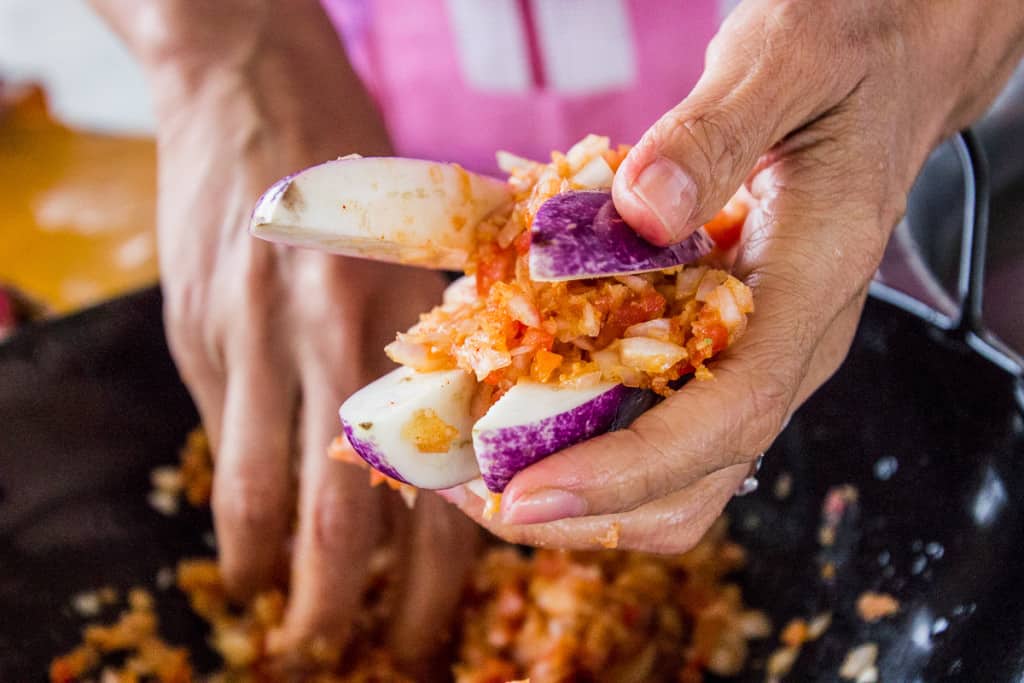
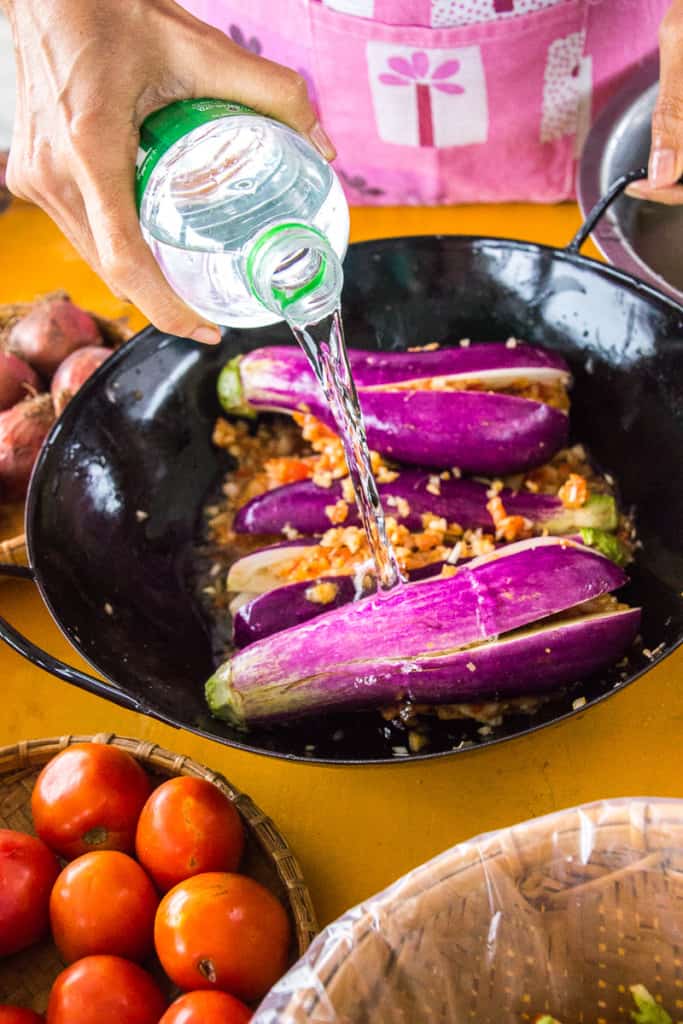
- Wash and dry the eggplants. Slice them down the centre from bottom to top, leaving the top section intact. Soak them in water while preparing the curry mix.
- Place the shallots, tomatoes, garlic, crushed peanuts, fish sauce, palm sugar, turmeric, salt and chilli powder into a mixing bowl and stir until all the flavours have mixed through completely. Remove the eggplants from the water and stuff with the shallot/tomato curry. Place in a large wok or frypan and cover with any remaining curry.
- Drizzle with vegetable oil and water, then cover and cook over a medium low heat. Cook for approximately 30 mins until the eggplants are soft and the liquid has mostly evaporated. You’ll be able to hear when the eggplants are close to done, as the sound will change from boiling to sizzling. Avoid lifting the lid while cooking.
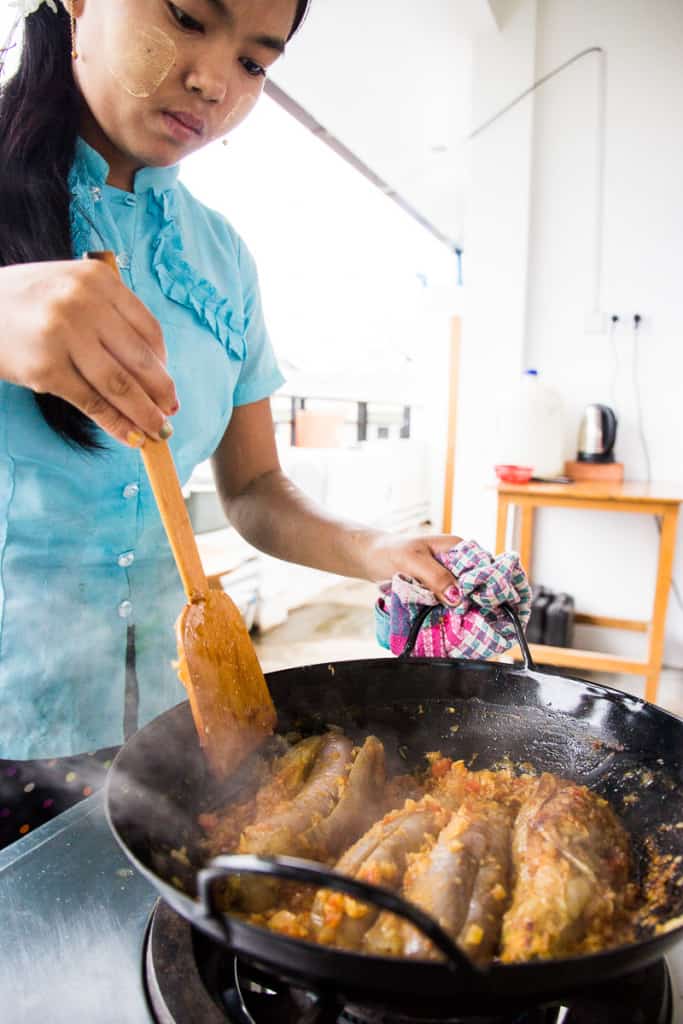

- Remove the lid and continue to cook until the eggplants are tender and brown and the liquid reduces. The curry may start sticking to the wok/frypan – this is totally okay! The caramelised flavour is a signature part of this dish.
- Serve with steamed white rice, a crisp salad and/or a helping of lemongrass chicken curry.
Wandercook’s Tips
- Slicing the Eggplants – The first trick we learned was to slice the eggplant in quarters, starting from the end and working through most of the way to the stalk, but leaving the top intact to hold it all together. No need to peel the eggplants either, the skin will help them hold their shape while cooking.
- Listening is Key – As I madly scribbled recipe notes during class, I looked over and saw Sarah and Su with their heads down near the pan. What on earth? Turns out you don’t need a crystal ball to know when the dish is ready – just listen! You’ll hear the difference as the boiling bubbling liquid evaporates into sizzling steaming deliciousness.
- Don’t Lift the Lid – Try really hard not to lift the lid until it had finished simmering away into melty soft heaven.
- Don’t Stress About Over-Cooking – Su told us that Khayan Thee Hnut means ‘stick to the pan’ in Burmese, and the more it sticks the better the flavour gets. One bite and the secret formula was clear: tender shallots + sweet palm sugar + simmering heat = caramelised eggplant goodness.
FAQs
Yes you can freeze it. Let it cool down first before popping into an air-tight freezer proof container. Store in the freezer for up to three months.
Variations
- Make it Less Sweet – It’s up to you if you want to include the jaggery, substitute with palm sugar or just leave it out altogether.
- Make it Go Further – Add extra veggies like sliced carrot or diced potatoes. For the potatoes, you might like to par-boil these separately for around 10 minutes while the eggplants are cooking, then add them in when you’re reducing the curry sauce.
- Amp Up the Heat – Add more chilli powder to your taste. Or for even more intense heat, swap for 1-2 birds eye chillies. These small chillies are deceptive – they really pack a punch! If you’re unsure, start with a small amount (even just half a chilli) until you’re familiar with the spice level.
- Make it Creamy – Add a tin (400 ml) coconut milk or coconut cream instead of water.
- Add Texture – Sprinkle fried shallots, fried garlic, crushed almonds or peanuts over the finished dish when serving.
- Add Protein – While not traditional, adding tofu would be a great way to add extra protein to this dish. The tofu would also taste amazing when cooked in these flavours!
- Make it Vegetarian – Leave out the fish sauce and shrimp powder, and add soy sauce or coconut amino sauce instead.
- Optional Garnish – Serve with a few fresh coriander leaves on top.
- Love Eggplant? – Try Japanese miso glazed eggplants (nasu dengaku) next!
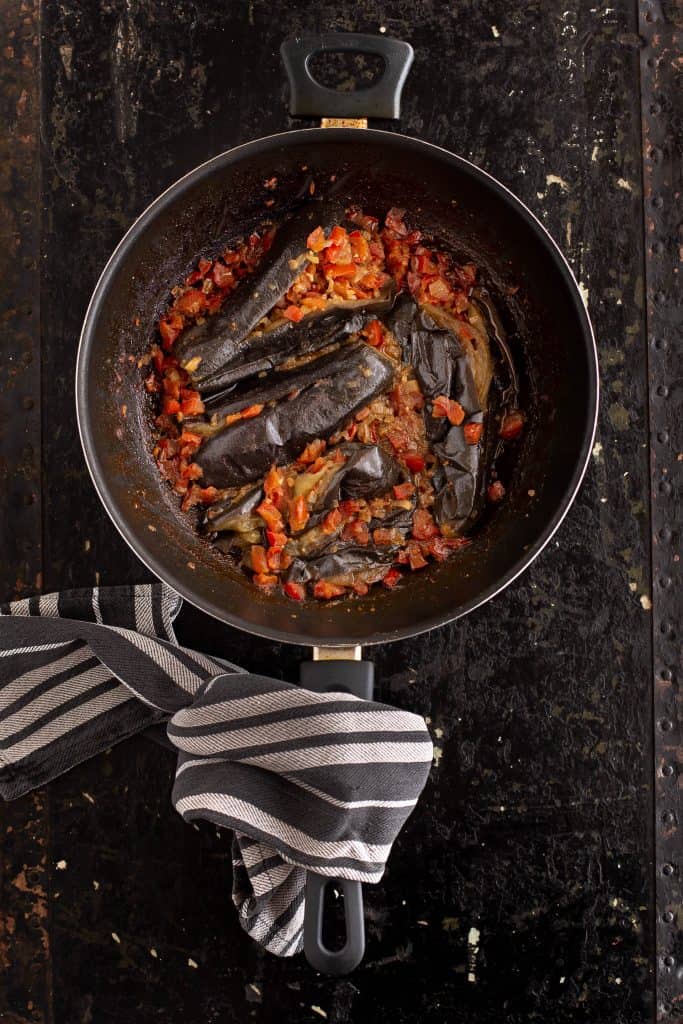
Try more of our favourite curries from around the world:
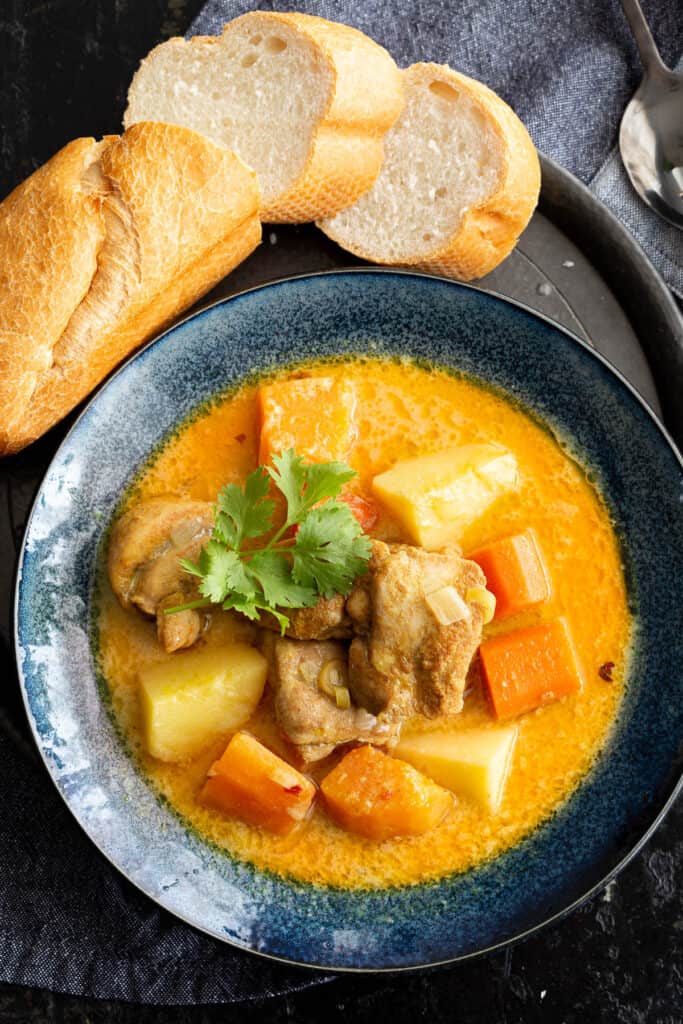
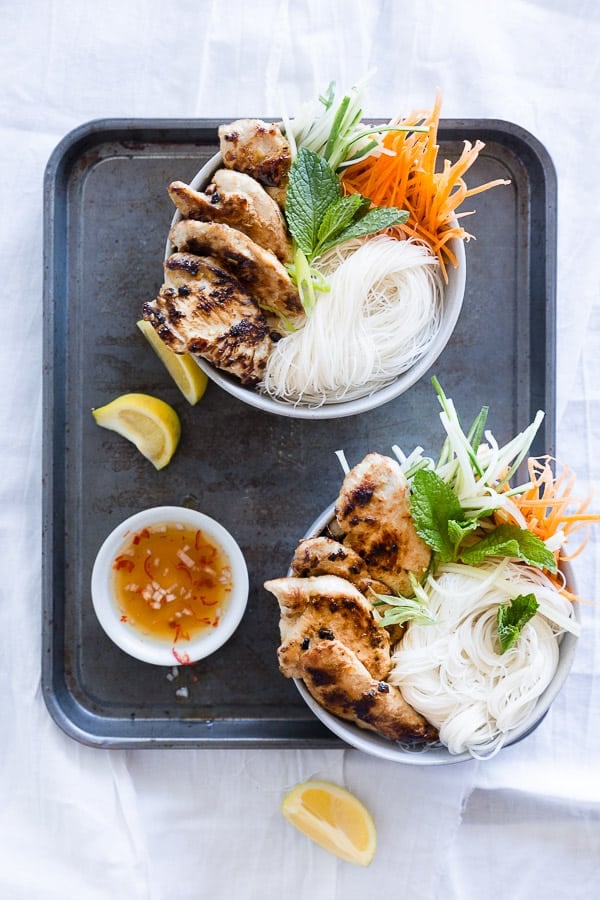
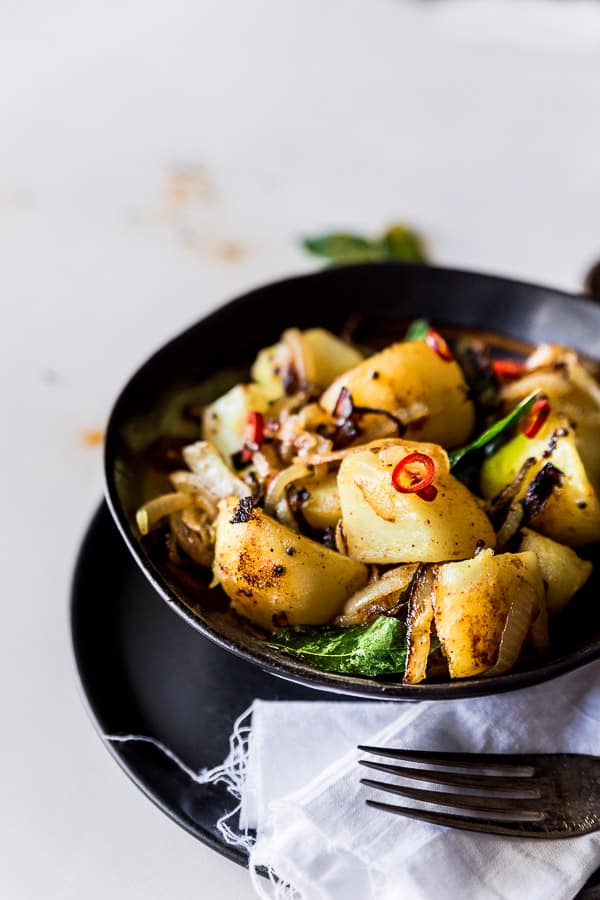
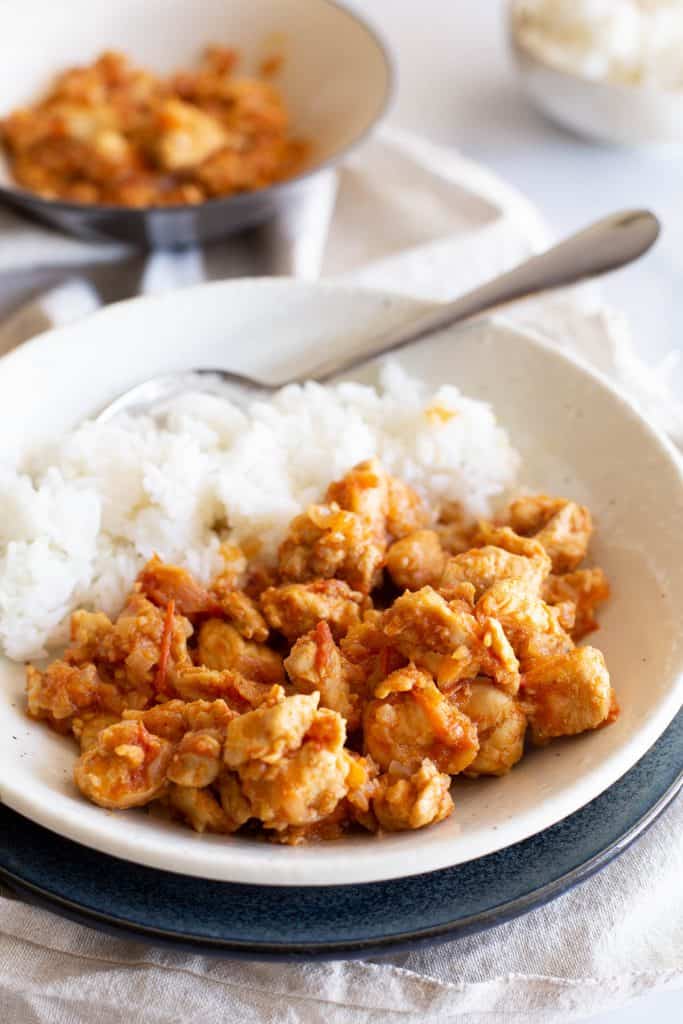
★ Did you make this recipe? Please leave a comment and star rating below!
Equipment
Ingredients
- 4 small eggplants
- 3-4 shallots finely chopped
- 3 medium tomatoes diced and seeds removed
- 2 cloves garlic chopped
- ½ tsp turmeric powder
- 3 tsp fish sauce
- ½ tsp salt
- 1 ½ tsp chilli powder
- 1 tbsp dried shrimp powder
- 2 tsp roasted peanuts crushed
- 2 tsp palm sugar or brown sugar
- 2 tbsp vegetable oil
- 1-2 cups cold water
Instructions
- Wash and dry the eggplants. Slice them down the centre from bottom to top, leaving the top section intact. Soak them in water while preparing the curry mix.4 small eggplants
- Place the shallots, tomatoes, garlic, dried shrimp powder, crushed peanuts, fish sauce, palm sugar, turmeric, salt and chilli powder into a mixing bowl and stir until all the flavours have mixed through completely. Remove the eggplants from the water and stuff with the shallot/tomato curry. Place in a large wok or frypan and cover with any remaining curry.3-4 shallots, 3 medium tomatoes, 2 cloves garlic, ½ tsp turmeric powder, 3 tsp fish sauce, ½ tsp salt, 1 ½ tsp chilli powder, 2 tsp roasted peanuts, 2 tsp palm sugar, 1 tbsp dried shrimp powder
- Drizzle with vegetable oil and water, then cover and cook over a medium low heat. Cook for approximately 30 mins until the eggplants are soft and the liquid has mostly evaporated. You’ll be able to hear when the eggplants are close to done, as the sound will change from boiling to sizzling. Avoid lifting the lid while cooking.2 tbsp vegetable oil, 1-2 cups cold water
- Remove the lid and continue to cook until the eggplants are tender and brown and the liquid reduces. The curry may start sticking to the wok/frypan – this is totally okay! The caramelised flavour is a signature part of this dish.
- Serve with steamed white rice, a crisp salad and/or a helping of lemongrass chicken curry.
Recipe Notes
- Eggplants – When we first cooked this in Myanmar we used long thin eggplants similar to Chinese/Japanese eggplant varieties. We’ve since cooked this with regular eggplants which work just as well. Slice the eggplants in quarters, starting from the end and working through most of the way to the stalk, but leaving the top intact to hold it all together. No need to peel the eggplants either, the skin will help them hold their shape while cooking.
- Palm Sugar – The authentic curry eggplant recipe uses a natural sweetener known as jaggery, which in Myanmar is sourced from the Toddy Palm tree. You can find it as a syrup or as a crumbly fudgy ball of buttery caramel flavour, so good that you can eat it on its own. At home, we substitute with gula melaka, palm sugar or brown sugar depending on what we have on hand.
- Fish Sauce – If you’ve never used fish sauce, find out more about it in our fish sauce guide. This staple Asian ingredient has a strong smell in the bottle, but isn’t fishy in the final dish, adding a delicious salty, savoury flavour to your cooking. You’ll find it at Asian grocers or in well-stocked supermarkets in the international foods section, or online.
- Dried Shrimp Powder – This is made from fresh baby shrimp/prawns that are dried and then ground into a fine powder. It’s very different from shrimp paste (such as Malaysian belacan or Indonesian terasi) which are fermented first. Look for it at an Asian grocery or get it online. If you have shrimp paste on hand, you can use this instead – start with 1/2-1 tsp and taste, then add more if you want it saltier. Otherwise, just add salt or an extra splash of fish sauce to taste.
- Listening Is Key – You’ll hear the difference as the boiling bubbling liquid evaporates into sizzling steaming deliciousness.
- Don’t Worry About Over-Cooking – Khayan Thee Hnut means ‘stick to the pan’ in Burmese, and the more it sticks the better the flavour gets.
- Variations:
- Make it Less Sweet – It’s up to you if you want to include the jaggery, substitute with palm sugar or just leave it out altogether.
- Make it Go Further – Add extra veggies like sliced carrot or diced potatoes. For the potatoes, you might like to par-boil these separately for around 10 minutes while the eggplants are cooking, then add them in when you’re reducing the curry sauce.
- Amp Up the Heat – Add more chilli powder to your taste. Or for even more intense heat, swap for 1-2 birds eye chillies. These small chillies are deceptive – they really pack a punch! If you’re unsure, start with a small amount (even just half a chilli) until you’re familiar with the spice level.
- Make it Creamy – Add a tin (400 ml) coconut milk or coconut cream instead of water.
- Add Texture – Sprinkle fried shallots, fried garlic, crushed almonds or peanuts over the finished dish when serving.
- Add Protein – While not traditional, adding tofu would be a great way to add extra protein to this dish. The tofu would also taste amazing when cooked in these flavours! If you don’t like tofu, try adding fish like one of our readers did. (Light fry the fish first before adding in with the tomato mix).
- Make it Vegetarian – Leave out the fish sauce and shrimp powder, and add soy sauce or coconut amino sauce instead.
- Optional Garnish – Serve with a few fresh coriander leaves on top.
Nutrition
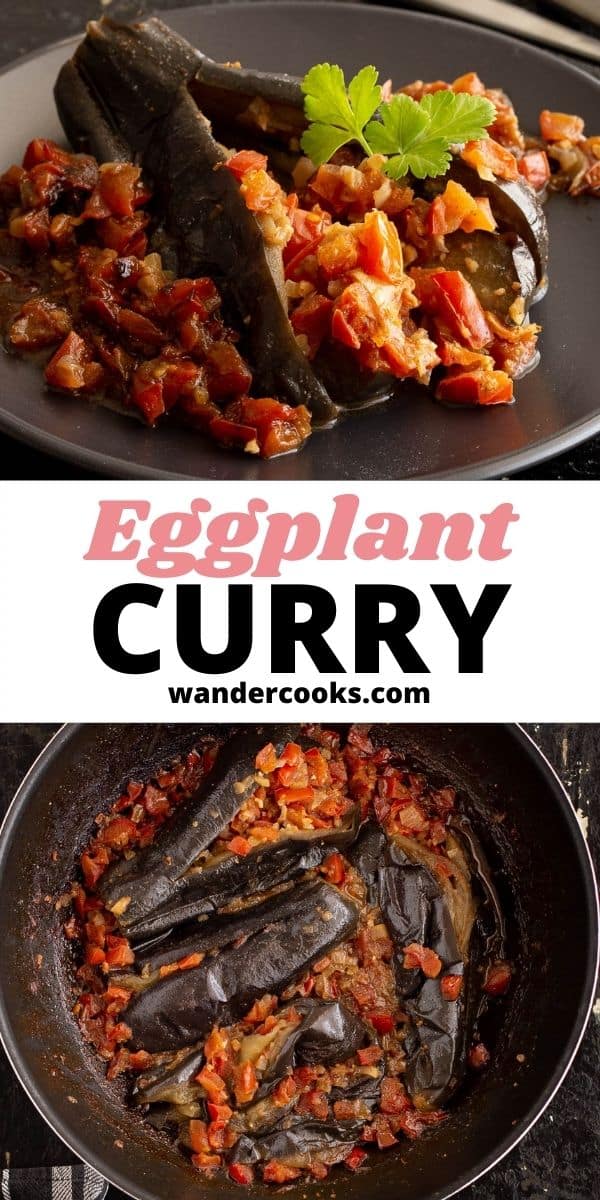




6 Comments
Rick
11/08/2022 at 2:34 amAre there any other vegetables that would go well in this same sauce rather than eggplant? I love eggplant. However, my partner doesn’t.
Wandercooks
12/08/2022 at 11:34 amHey Rick! We haven’t tested any other veggies with this, however, I’d try it with zucchini and see how that comes out, as it’s similar in size and texture to eggplant. You may not need to cook it for as long though!
Jacqui
16/01/2019 at 1:15 amReally delicious Khayan Thee Hnut. It’s very hard to find Burmese recipes that are the real deal or close to it, and yours certainly is. I’m Burmese and was brought up on this dish. My mum’s version is great and very close to yours but my mum doesn’t put the jagree in it. So I gave your version a go and I really liked the added sweetness! So yummy!
Wandercooks
16/01/2019 at 3:30 pmHi Jacquie – wow that’s awesome, thank you so much for your feedback and glad it passed the taste test! This was one of our favourite recipes learned while we were in Mandalay – it has so much flavour for such simple, wonderful ingredients. We’ve been wanting to grow our own eggplants ever since!
Lillian
07/11/2015 at 4:03 amI was just looking at a Recipe for Khayan Thee Hnut on the Saveur website and thought I would look and see if I could find a more authentic version. Yours seems much more interesting and I am going to try it today 😉 Maybe I’ll let you know how I did…
Wandercooks
07/11/2015 at 11:15 amOh yes, please do! Thanks for getting in touch Lillian, this recipe is super popular in Mandalay. Send us a picture or tag us @wandercooks online when you do, we’d love to see how you go 🙂